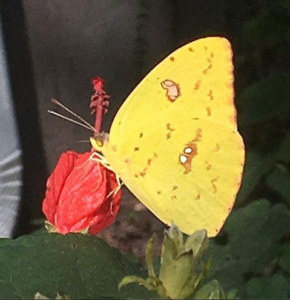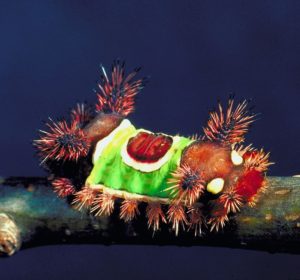Wildlife Wednesday: Insect Friends in the Garden
A couple of were working out in the herb garden behind the Nature Center building (the Henshaw House) a few days ago, digging in the soil and pulling out weeds, and we noticed several animals living or spending time in the garden as well. This week, we thought we’d give you a little survey of some of the creatures that are currently moving around the herbs.
 Most people who grow Mexican Milkweed in their gardens expect Monarch Butterflies, and even the tiny yellow milkweed aphids, on their milkweed plants, but we were surprised to notice, a couple of years ago, that our herb garden milkweed had also attracted bright yellow and black Milkweed Leaf Beetles (Labidomera clivicollis). Like monarch caterpillars, these round conspicuous beetles feed on the poisonous leaves of the milkweed, and are therefore toxic to predators, as well. The
Most people who grow Mexican Milkweed in their gardens expect Monarch Butterflies, and even the tiny yellow milkweed aphids, on their milkweed plants, but we were surprised to notice, a couple of years ago, that our herb garden milkweed had also attracted bright yellow and black Milkweed Leaf Beetles (Labidomera clivicollis). Like monarch caterpillars, these round conspicuous beetles feed on the poisonous leaves of the milkweed, and are therefore toxic to predators, as well. The  beetles come on black and yellow, black and red, and black and orange.
beetles come on black and yellow, black and red, and black and orange.
There were a number of butterflies, but the 2 that were the most conspicuous were the Gulf Fritillary (Agraulis vanillae, above) and the Cloudless Sulphur (Phoebis sennae, right), as well as a few Monarchs. Gulf Fritillaries are not related to other fritillary butterflies, but are actually a kind of Heliconian, or longwing butterfly. The larvae feed on passion vines, and they keep emerging through the summer and fall in this area until low temperatures prevail. Cloudless Sulphur caterpillars feed on legumes, and both migrate here from the North and continue to emerge here into the Fall.
Ea stern Leaf-footed Bugs (Leptoglossus phyllopus) are one of 3 common leaf-footed bugs that are found in our park throughout the year. We’ve seen the adults, and the red wingless nymphs prowling around plants in the garden. They feed on plants by piercing them with a straw-like proboscis and sucking juices out of the plant. The inject chemicals into the plants to aid in feeding, and these secretions may be somewhat toxic to the plant. In small amounts, this isn’t harmful, but in large numbers may kill the plant.They are harmless to people, but they may release a foul smelling substance when bothered.
stern Leaf-footed Bugs (Leptoglossus phyllopus) are one of 3 common leaf-footed bugs that are found in our park throughout the year. We’ve seen the adults, and the red wingless nymphs prowling around plants in the garden. They feed on plants by piercing them with a straw-like proboscis and sucking juices out of the plant. The inject chemicals into the plants to aid in feeding, and these secretions may be somewhat toxic to the plant. In small amounts, this isn’t harmful, but in large numbers may kill the plant.They are harmless to people, but they may release a foul smelling substance when bothered.
Another small creature that we found all over the herb garden were Asian Many-spotted Ladybird Beetle (Harmonia axyridis) larvae. They of course look nothing like their red black spotted parents, but just like their parents, they are voracious predators, feeding mainly on aphids and other tiny plant sucking insects. They are a non-native invasive species, and negatively impact native ladybug populations. As with most ladybugs, they are toxic, and this is one of the few ladybugs (even as larvae) that may bite if handled.
Though the temperatures are dropping, its still possible to see some of these creatures in our gardens, and perhaps even in your own garden at home. If you get a chance some time soon, drop by and see what you can find.
Thanks for joining us this week, and see you soon!
Eric Duran
Staff Naturalist
Photographs by Eric Duran





 The most infamous of our stinging caterpillars is the Asp or the caterpillar of the Southern Flannel Moth (Megalopyge opercularis, pictured right). Asps usually emerge from their eggs in mid to late Autumn, and are commonly found in or near hardwood trees, shrubs, and vines. They feed on the leaves of these plants, and wander around constantly, looking for food, and eventually for decent locations to make their cocoons. They may be various shades of brown and gray, with a fur ridge down the middle of the back.
The most infamous of our stinging caterpillars is the Asp or the caterpillar of the Southern Flannel Moth (Megalopyge opercularis, pictured right). Asps usually emerge from their eggs in mid to late Autumn, and are commonly found in or near hardwood trees, shrubs, and vines. They feed on the leaves of these plants, and wander around constantly, looking for food, and eventually for decent locations to make their cocoons. They may be various shades of brown and gray, with a fur ridge down the middle of the back. 
 The Spiny Oak Slug (Euclea delphinii) is the caterpillar of an adorable furry little green and brown cup moth (pictured above right). While the caterpillar is really quite beautiful with its intricate designs of yellow and green or brown and orange, the pain from the stings is not at all adorable. These small spiny larvae (growing to only 2 cm long) feed on a wide variety of leaves from deciduous trees, bushes, and vines. In the South, they have 2 generations, one in the Summer, and another active in Fall.
The Spiny Oak Slug (Euclea delphinii) is the caterpillar of an adorable furry little green and brown cup moth (pictured above right). While the caterpillar is really quite beautiful with its intricate designs of yellow and green or brown and orange, the pain from the stings is not at all adorable. These small spiny larvae (growing to only 2 cm long) feed on a wide variety of leaves from deciduous trees, bushes, and vines. In the South, they have 2 generations, one in the Summer, and another active in Fall.
 Well, we hope this little mini-guide to stinging Fall caterpillars helps you stay safe out in your yard, garden, and out in area parks in the coming weeks. Though painful at times, they are important herbivores in our native ecosystems, and they really can be quite beautiful and even endearing.
Well, we hope this little mini-guide to stinging Fall caterpillars helps you stay safe out in your yard, garden, and out in area parks in the coming weeks. Though painful at times, they are important herbivores in our native ecosystems, and they really can be quite beautiful and even endearing.